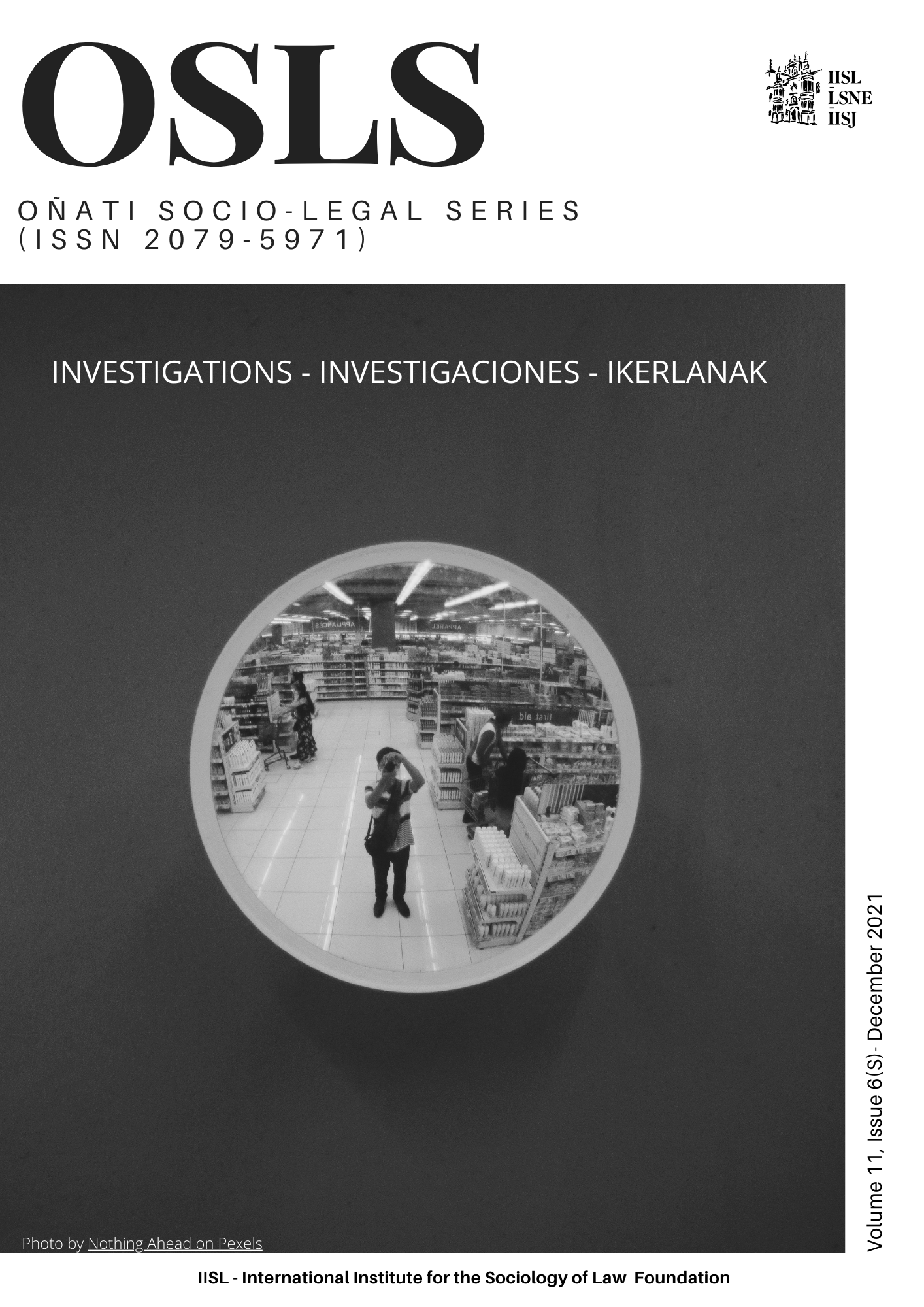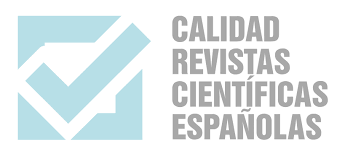Combating (child) human trafficking
A challenge between repression tools and detection of vulnerability
DOI:
https://doi.org/10.35295/osls.iisl/0000-0000-0000-1206Keywords:
Child human trafficking, vulnerability, children’s rights, sexual exploitation, crime, institutional actors, social actorsAbstract
The aim of this article is to reconceptualise the notion of child trafficking by seeking to understand child vulnerability and agency. The research approach focuses on criminal judgements pronounced in Italian courts and assesses how institutional interpretations support perceptions of vulnerability or agency that are often promoted or defined by criminal law perspectives. The attempt is to investigate human trafficking both as a multifaceted phenomenon and as a process to link together the functioning of elements of the human trafficking system that as a prism assumes different shapes in a growing complexity.
Downloads
Metrics
Global Statistics ℹ️
|
1060
Views
|
815
Downloads
|
|
1875
Total
|
|
References
Abbamonte, O., 2001. Le ragioni del decidere. per un possibile studio della giurisprudenza e della mentalità del giudice. Sociologia del diritto, no. 2, 5-44.
Action plan to combat organized crime (Adopted by the Council on 28 April 1997) (97/C 251/01). Official Journal [online], C 251, 15/08/1997 P. 0001 – 0016. Available from: https://eur-lex.europa.eu/legal-content/EN/TXT/HTML/?uri=CELEX:51997XG0815&from=EN [Access 24 May 2021].
Adhikari, S.D., and Turton, J., 2020. Understanding “trafficking vulnerabilities” among children: the responses linking to child protection issues in Nepal. Children's Geographies [online], 18(4), 393–405. Available from: https://doi.org/10.1080/14733285.2019.1676398 [Access 24 May 2021]. DOI: https://doi.org/10.1080/14733285.2019.1676398
Agamben, G., 2008. Il sacramento del linguaggio: Archeologia del giuramento. Bari: Laterza.
Ambrosini, M., 2018. Prefazione. Lottare contro le nuove schiavitù richiede anzitutto di comprenderle. In: M.A. Quiroz Vitale, Diritti umani e cultura giuridica: Il principio di autodeterminazione e l’invenzione delle nuove schiavitù in Europa. Milan: Mimesis, 13–15.
Anti-Slavery International, Transparency International and United Nations Office on Drugs and Crime, 2011. The Role of Corruption in Trafficking in Persons [online]. Issue paper. Vienna: UNODC. Available from: https://www.unodc.org/documents/human-trafficking/2011/Issue_Paper_-_The_Role_of_Corruption_in_Trafficking_in_Persons.pdf [Access 24 May 2021].
Barrenechea, A., (with C. Falconer, ed.), 2016. Access to Compensation for Victims of Human Trafficking [online]. Working paper. July. London: FLEX. Available from: https://www.antislaverycommissioner.co.uk/media/1066/dwp-compensation-f.pdf [Access 24 May 2021].
Bruno, E., 2017. Le vittime di tratta ed il programma di emersione di cui all’art. 18 comma 3 bis del D.Lgs. 25 luglio 1998 n. 286. Minorigiustizia [online], 3, 152–162. Available from: https://doi.org/10.3280/MG2017-003014 [Access 24 May 2021]. DOI: https://doi.org/10.3280/MG2017-003014
Campana, P., 2016. Explaining criminal networks: Strategies and potential pitfalls. Methodological Innovations [online], 2. Available from: https://doi.org/10.1177/2059799115622748 [Access 24 May 2021]. DOI: https://doi.org/10.1177/2059799115622748
Campana, P., 2018. Out of Africa: The organization of migrant smuggling across the Mediterranean. European Journal of Criminology [online], 15(4), 481–502. Available from: https://doi.org/10.1177/1477370817749179 [Access 24 May 2021]. DOI: https://doi.org/10.1177/1477370817749179
Carchedi, F., 2004. Prostituzione migrante e donne trafficate. Milan: Franco Angeli.
Communication from the Commission [of the European Communities] to the Council and the European Parliament on trafficking in women for the purpose of sexual exploitation (COM (96) 567 final) [online]. Brussels, 20 November 1996. Available from: https://eur-lex.europa.eu/LexUriServ/LexUriServ.do?uri=COM:1996:0567:FIN:EN:PDF [Access 24 May 2021].
Coppola, V., Howard, P., and Inverno, A., 2020. Piccoli schiavi invisibili. L’impatto del COVID-19 sulla tratta e lo sfruttamento: dalle strade all’online [online]. Save the Children. Available from: https://www.savethechildren.it/cosa-facciamo/pubblicazioni/piccoli-schiavi-invisibili-2020 [Access 24 May 2021].
De Felice, D., et al., 2013. Information Extraction and Social Network Analysis of Criminal Judgements. A sociological and Computational Approach. Informatica e Diritto, 1, 243–261.
De Felice, D., Lombardo, E., and Salerno, G., 2019. La tratta di esseri umani minorenni. Quadro normativo e percorsi di cittadinanza. Sociologia del diritto [online], vol. 1, pp. 53–84. Available from: https://doi.org/10.3280/SD2019-001003 [Access 24 May 2021]. DOI: https://doi.org/10.3280/SD2019-001003
Di Donato, F., 2008. La costruzione giudiziaria del fatto: Il ruolo della narrazione nel “processo”. Milan: Franco Angeli.
Di Nicola, A., 2016. Via dalla guerra con me: parola di trafficante. Rassegna Italiana di criminologia, no. 3, 201–208.
Di Ronco, A., 2020. Law in action: Local-level prostitution policies and practices and their effects on sex workers. European Journal of Criminology [online], First Published 23 July, 1–19. Available from: https://doi.org/10.1177/1477370820941406 [Access 24 May 2021]. DOI: https://doi.org/10.1177/1477370820941406
Directive 2011/36/EU of the European Parliament and of the Council of 5 April 2011. Official Journal of the European Union [online], L 101/1, of 15 April. Available from: https://eur-lex.europa.eu/LexUriServ/LexUriServ.do?uri=OJ:L:2011:101:0001:0011:EN:PDF [Access 24 May 2021].
Esser, J., 1983. Precomprensione e scelta del metodo nel processo di individuazione del diritto. Naples: Esi.
Europol, 2019. Action week against human trafficking: 323 potential victims identified, 46 suspected traffickers arrested. Press release. Europol newsroom [online], 27 May. Available from: https://www.europol.europa.eu/newsroom/news/action-week-against-human-trafficking-323-potential-victims-identified-46-suspected-traffickers-arrested [Access 24 May 2021].
Europol, 2020. Catching the virus. Cybercrime, disinformation and the COVID-19 pandemic [online]. Report. 3 April. Available from: https://www.europol.europa.eu/publications-documents/catching-virus-cybercrime-disinformation-and-covid-19-pandemic [Access 10 November 2020].
Giura, G., 2015. I delitti di criminalità organizzata in Sicilia: Un’analisi socio-giuridica della giurisprudenza. Milan: Mimesis.
Haddon, L., and Vincent, J., eds., 2014. European children and their carers’ understanding of use, risks and safety issues relating to convergent mobile media [online]. Report D4.1. Milan: Unicatt. Available from: https://netchildrengomobile.eu/ncgm/wp-content/uploads/2013/07/NCGM_QualitativeReport_D4.pdf [Access 24 May 2021].
Internal Displacement Monitoring Centre (IDMC), 2018. Global Report on Internal Displacement 2018 [online]. Available from: https://www.internal-displacement.org/global-report/grid2018/ [Access 24 May 2021].
International Labour Organization (ILO), 2017. Global estimates of modern slavery: Forced labour and forced marriage [online]. Report. Geneva: International Labour Organization. Available from: https://www.ilo.org/wcmsp5/groups/public/---dgreports/---dcomm/documents/publication/wcms_575479.pdf [Access 24 May 2021].
Johansson, Y., 2020. Opening statement by Commissioner Johansson on “Schengen, migration and asylum policy and the EU security strategy in the context of COVID-19” at the European Parliament Committee on Civil Liberties, Justice and Home Affairs [online]. Transcription of speech. 7 May. European Commission Directorate-General for Communication. Available from: https://ec.europa.eu/commission/commissioners/2019-2024/johansson/announcements/opening-statement-commissioner-johansson-schengen-migration-and-asylum-policy-and-eu-security_en [Access 24 May 2021].
Joint Action of 24 February 1997 adopted by the Council on the basis of Article K.3 of the Treaty on European Union concerning action to combat trafficking in human beings and sexual exploitation of children (97/154/JHA). Official Journal [online], L 063 , 04/03/1997 P. 0002 – 0006. Available from: https://eur-lex.europa.eu/legal-content/EN/TXT/HTML/?uri=CELEX:31997F0154&from=EN [Access 24 May 2021].
Kehl, D., Guo, P., and Kessler, S., 2017. Algorithms in the Criminal Justice System: Assessing the Use of Risk Assessments in Sentencing. Responsive Communities Initiative, Berkman Klein Center for Internet & Society, Harvard Law School.
Lisborg, A., 2014. The Good, the Bad and the Ugly: In the Name of Victim Protection. In: S. Yea, ed., Human Trafficking in Asia: Forcing Issues. London: Routledge, 19–34.
Luhmann, N., 1990. Sistemi sociali: Fondamenti di una teoria generale. Trans.: A. Febbrajo, R. Schmidt. Bologna: Il Mulino.
Malsch, M., and Carrière, R., 1999. Victims wishes for compensation: the immaterial aspect. Journal of Criminal Justice, 27(3), 239–247. DOI: https://doi.org/10.1016/S0047-2352(98)00062-2
Meier, R.F., Kennedy, L.W., Sacco V.F., edt., 2001. The Process and Structure of Crime: Criminal Events and Crime Analysis, Somerset, United Kingdom: Taylor & Francis Inc.
O’Brien, E., 2013. Ideal Victims in Human Trafficking Awareness Campaigns. In: K. Carrington et al., eds., Crime, Justice and Social Democracy: International Perspective. Basingstoke: Palgrave Macmillan, 315–326. DOI: https://doi.org/10.1057/9781137008695_21
Paoli, L., 2002. The paradoxes of organized crime. Crime, Law & Social Change, no. 37, 51–97. DOI: https://doi.org/10.1023/A:1013355122531
Pennisi, C., and Giura, G., 2009. Un’analisi empirica della giurisprudenza sulla criminalità organizzata e di tipo mafioso. Antigone, no. 2–3, 125–162.
Prina, F., 2008. La tratta di persone in Italia: Il sistema degli interventi a favore delle vittime (vol. 3). Milan: Franco Angeli.
Quiroz Vitale, M.A., 2018. Diritti umani e cultura giuridica: Il principio di autodeterminazione e l’invenzione delle nuove schiavitù in Europa. Milan: Mimesis.
Qvortrup, J., 1995. From Useful to Useful: The Historical Continuity of Children’s Constructive Participation. Sociological Studies of Children, 7(1), 49–76.
Qvortrup, J., 2008. Macroanalysis of Childhood. In: P. Christensen and A. James, eds., Research with children: Perspectives and Practices. New York: Routledge.
Resta, E., 2000. Tra responsabilità e pena. Democrazia e diritto, 2, 184–201.
Ronfani, P., 1995. I diritti del minore: Cultura giuridica e rappresentazioni sociali. Milan: Guerini Scientifica.
Ronfani, P., 2013. Prefazione. In: G. Maggioni et al., eds., Bambini e genitori: Norme, pratiche e rappresentazioni della responsabilità. Rome: Donzelli.
Rousseau, J.J. (with P. Massimi, trans. and ed.), 1969. Emilio o dell’educazione. Rome: Armando. (Originally published in 1762).
Save the Children Italia Onlus, 2017. Piccoli schiavi invisibili: I minori stranieri vittime di tratta e sfruttamento in Italia [online]. Available from:https://www.savethechildren.it/sites/default/files/files/uploads/pubblicazioni/piccoli-schiavi-invisibili-2017.pdf [Access 24 May 2021].
Seidl, D., and Becker, K.H., 2006. Organizations as Distinction Generating and Processing Systems: Niklas Luhmann’s Contribution to Organization Studies. Organization, 13(1), 9–35. DOI: https://doi.org/10.1177/1350508406059635
Shelley, L., 2010. Human Trafficking: A Global Perspective. Cambridge University Press. DOI: https://doi.org/10.1017/CBO9780511760433
Todres, J., 2011. Moving Upstream: The Merits of a Public Health Law Approach to Human Trafficking. North Carolina Law Review [online], 89(2), 447. Available from:http://ssrn.com/abstract=1742953 [Access 24 May 2021].
Torrioni, P.M., 2013. Diventare autonomi, dimostrarsi responsabili. In: G. Maggioni et al., eds., Bambini e genitori: Norme, pratiche e rappresentazioni della responsabilità. Rome: Donzelli.
UN General Assembly, 2016. Report of the Special Rapporteur on contemporary forms of slavery, including its causes and consequences (A/HRC/33/46) [online]. UN Human Rights Council, 33rd session, 3 August. Available from: https://documents-dds-ny.un.org/doc/UNDOC/GEN/G16/142/67/PDF/G1614267.pdf?OpenElement [Access 24 May 2021].
UN General Assembly, 2017a. Joint report of the Special Rapporteur on the sale and sexual exploitation of children, including child prostitution, child pornography and other child sexual abuse material and the Special Rapporteur on trafficking in persons, especially women and children (A/72/164) [online]. 72nd session, 18 July: Promotion and protection of the rights of children. Available from: https://undocs.org/en/A/72/164 [Access 24 May 2021].
UN General Assembly, 2017b. Report of the Special Rapporteur on the right to education: realizing the right to education through non-formal education (A/HRC/35/24) [online]. UN Human Rights Council, 35th session, 6–23 June. Available from: https://undocs.org/A/HRC/35/24 [Access 24 May 2021].
United Nations Office on Drugs and Crime (UNODC), 2016. Global Report on Trafficking in Persons (Sales No. E.16.IV.6) [online]. Vienna: UNODC. Available from: https://www.unodc.org/documents/data-and-analysis/glotip/2016_Global_Report_on_Trafficking_in_Persons.pdf [Access 24 May 2021].
United Nations Office on Drugs and Crime (UNODC), 2020. Global Report on Trafficking in Persons 2020 (Sales No. E.20.IV.3) [online]. Vienna: UNODC. Available from: https://www.unodc.org/documents/data-and-analysis/tip/2021/GLOTiP_2020_15jan_web.pdf [Access 24 May 2021].
Venturoli, M., 2015. La vittima nel sistema penale dall’oblio al protagonismo. Naples: Jovene.
Vijeyarasa, R., 2015. Sex, Slavery and the Trafficked Woman: Myths and Misconceptions About Trafficking and its Victims. London: Routledge. DOI: https://doi.org/10.4324/9781315608501
Wells, K., 2009. Childhood in a Global Perspective. Cambridge/Malden: Polity Press.
Winterdyk, J., 2018. Combating (Child) Human Trafficking: Building Capacity. Oñati Socio-Legal Series [online], 8(1), pp. 106–129. Available from: https://doi.org/10.35295/osls.iisl/0000-0000-0000-0921 [Access 24 May 2021]. DOI: https://doi.org/10.35295/osls.iisl/0000-0000-0000-0921
Wyness, M., 2012. Childhood and Society. 2nd ed. Basingstoke: Palgrave Macmillan. DOI: https://doi.org/10.1007/978-0-230-35725-9
Published
How to Cite
Issue
Section
License
Copyright (c) 2021 Deborah De Felice

This work is licensed under a Creative Commons Attribution-NonCommercial-NoDerivatives 4.0 International License.
OSLS strictly respects intellectual property rights and it is our policy that the author retains copyright, and articles are made available under a Creative Commons licence. The Creative Commons Non-Commercial Attribution No-Derivatives licence is our default licence and it regulates how others can use your work. Further details available at https://creativecommons.org/licenses/by-nc-nd/4.0 If this is not acceptable to you, please contact us.
The non-exclusive permission you grant to us includes the rights to disseminate the bibliographic details of the article, including the abstract supplied by you, and to authorise others, including bibliographic databases, indexing and contents alerting services, to copy and communicate these details.
For information on how to share and store your own article at each stage of production from submission to final publication, please read our Self-Archiving and Sharing policy.
The Copyright Notice showing the author and co-authors, and the Creative Commons license will be displayed on the article, and you must agree to this as part of the submission process. Please ensure that all co-authors are properly attributed and that they understand and accept these terms.























